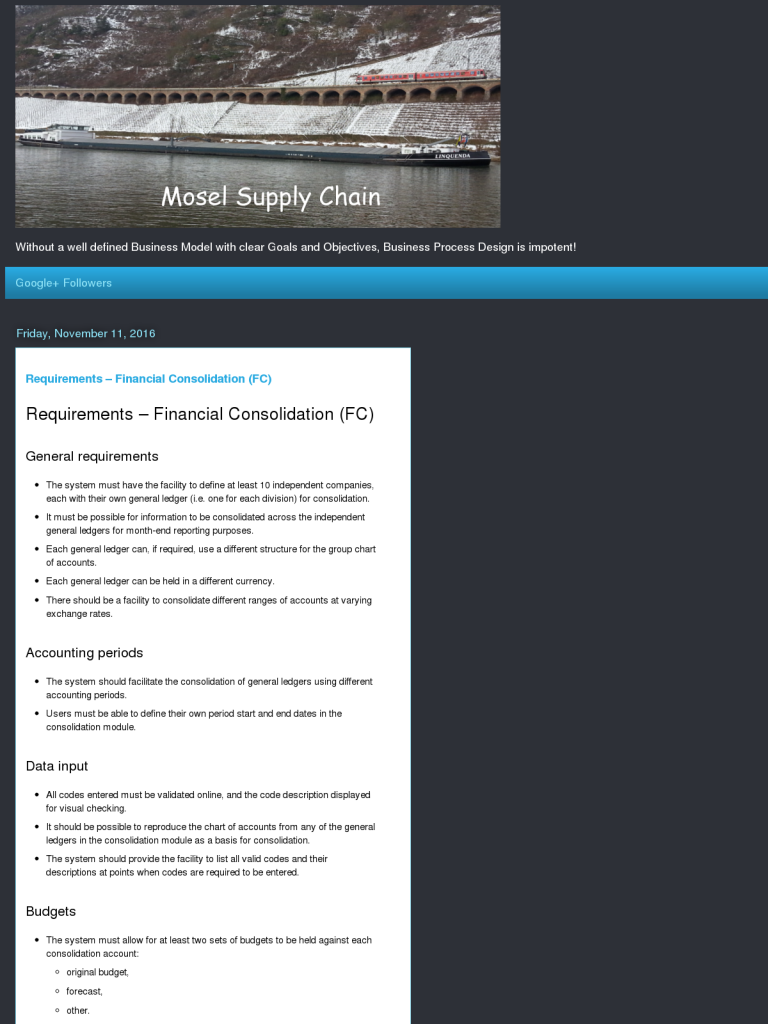Requirements – Financial Consolidation (FC)
Blog: Biz-Performance, David Brown
Requirements – Financial Consolidation (FC)
General requirements
-
The system must have the facility to define at least 10 independent companies, each with their own general ledger (i.e. one for each division) for consolidation.
-
It must be possible for information to be consolidated across the independent general ledgers for month-end reporting purposes.
-
Each general ledger can, if required, use a different structure for the group chart of accounts.
-
Each general ledger can be held in a different currency.
-
There should be a facility to consolidate different ranges of accounts at varying exchange rates.
Accounting periods
-
The system should facilitate the consolidation of general ledgers using different accounting periods.
-
Users must be able to define their own period start and end dates in the consolidation module.
Data input
-
All codes entered must be validated online, and the code description displayed for visual checking.
-
It should be possible to reproduce the chart of accounts from any of the general ledgers in the consolidation module as a basis for consolidation.
-
The system should provide the facility to list all valid codes and their descriptions at points when codes are required to be entered.
Budgets
-
The system must allow for at least two sets of budgets to be held against each consolidation account:
-
original budget,
-
forecast,
-
other.
-
The system must allow the following year’s budget(s) to be set up without overwriting the current year’s budget(s).
-
It must be possible to budget at a higher level than that at whic transactions are input, ie some accounts are only budgeted at income/expense code level, others at sub-account level.
-
There should be facilities for phasing an annual budget over the various accounting periods on the basis:
-
of equal monthly apportionment,
-
a monthly profile (of which there may be more than one).
-
It should be possible for budgets to be generated automatically from a previous year’s actuals or budgets, with a percentage increase or decrease per account code range.
Transaction input
-
The system must support batch control on input, with agreement of batch controls before acceptance for posting.
-
Batch numbers will be system generated.
-
Batches should be limited to a single period.
-
Batches should be written to a holding file and be available for recall and modification before posting.
-
It should be possible for valid batches to be posted selectively by the user.
-
The system should provide the facility for users to define their own transaction types, eg month-end allocation journals.
-
It is anticipated that the following fields will be held in the batch header:
-
transaction type,
-
transaction reference,
-
transaction date,
-
accounting period (unless automatically derived from the date).
-
It is anticipated that the following fields will be held for each line item:
-
account code,
-
description (min 30 characters),
-
value,
-
debit/credit.
Enquiry faclities
-
The following will be available on entry of an account code per period:
-
net movement,
-
budget and variance,
-
previous year and variance.
Reporting
-
The following reports must be available:
-
trial balance,
-
profit and loss account,
-
balance sheet,
-
net movement by account showing opening balance at start of the month, net transactions and closing balance,
-
other ad hoc reports, particularly in relation to transactions.
-
It is anticipated that most reports will be produced by means of an end-user report writer. Such a report writer should be able to access all data items in the database to enable a wide range of custom reports to be written.
-
The report writer must be able to use the following values:
-
current month actual,
-
current month budget,
-
current month last year,
-
year to date actual,
-
year to date budget,
-
year to date last year,
-
variances between actual and any of the budgets/prior year.
-
It should support the following features:
-
sort routines,
-
extraction by criteria,
-
control level breaks,
-
suppression of zero prints,
-
ability to round reports to the nearest thousand,
-
automatic formatting,
-
on-line viewing,
-
variable width,
-
user defined columns,
-
user defined rows,
-
arithmetic calculations horizontally,
-
arithmetic calculations vertically.
-
It should support the ability to define a range of account codes, so that each each account and its description and other selected fields are automatically displayed.
Consolidation routine
-
It should be possible to consolidate one, several or all companies on request.
-
The facility for reading general ledger data from a disk should be available when producing the consolidation file to avoid unnecessarily using up disk space.
-
A flag should indicate the status of the consolidation system, i.e. whether the consolidation has been run, aborted, completed, etc.
Leave a Comment
You must be logged in to post a comment.








